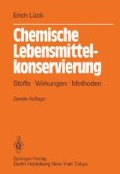Zusammenfassung
Salz wird bereits im alten Testament als Speisezutat mit kultischem Charakter erwähnt. Als Konservierungsstoff für Lebensmittel war es im friihen Ägypten [1] und im vorderen Orient ebenso bekannt wie im alten Rom [2]. Muria, Garum, Liquamen und Alec (auch Alex) waren Zubereitungen mit Kochsalz als wesentlichem Bestandteil. Sie dienten zur Würzung und zur Erhaltung von Lebensmitteln verschiedener Art [3]. In Zentral- und Nordeuropa war Salz im Mittelalter ein wichtiger Handelsartikel. Städtenamen (Halle) und Salzstraßen (Hellwege) erinnern daran. Obwohl Salz vor 200 Jahren doppelt so viel kostete wie Rindfleisch, war es jahrhundertelang der wichtigste, wenn nicht einzige in großem Umfang verwendete Konservierungsstoff, besonders für Fleisch, Fisch und Gemüse.
Access this chapter
Tax calculation will be finalised at checkout
Purchases are for personal use only
Preview
Unable to display preview. Download preview PDF.
Übersichtsliteratur
Emons, H.-H. und Walter, H.-H.: Mit dem Salz durch die Jahrtausende. Geschichte des weißen Goldes von der Urzeit bis zur Gegenwart. Leipzig: Deutscher Verlag für Grundstoffindustrie 1984
Spezielle Literatur
Netolitzky, F.: Nahrungs- und Heilmittel der Urägypter. Z.Unters. Nahrungs. Genußm. 26, 425–427 (1913)
Forbes, R.J.: Studies m ancient technology. Band 3. Leiden: Brill. 2. Aufl. 1965, S. 164–181
Binkerd, E.F. und Kolari, O.E.: The history and use of nitrate and nitrite in the curing of meat. Food Cosmet. Toxicol. 13, 655–661 (1975)
Kaufmann, D.W.: Sodium chloride. The production and properties of salt and brine. New York: Reinhold 1960
Boyd, E.M. und Shanas, M.N.: The acute oral toxicity of sodium chloride. Arch. Intern. Phar- macodyn. Ther. 144, 86–98 (1963)
Boyd, E.M. und Boyd, C.E.: Toxicity of pure foods. Cleveland: CRC Press 1973, S. 163–181
Boyd, E.M., Abel, M.M. und Knight, L.M.: The chronical oral toxicity of sodium chloride at the range of the LD50 (0.1 L). Can. J.Physiol. Pharmacol. 44, 157–172 (1966)
Meneely, G.R., Tucker, R.G. und Darby, W.J.: Chronic sodium chloride toxicity in albino rats. J.Nutr. 48, 489–498 (1952)
Battarbee, H.D. und Meneely, G.R.: The toxicity of salt. Crit. Rev. Toxicol. 5, 355–376 (1978)
Meneely, G.R., Tucker, R.G., Darby, W.J. und Auerbach, S.H.: Chronic sodium chloride toxicity: Hypertension, renal and vascular lesions. Ann. Int. Med. 39, 991–998 (1953)
Kushner, D.J.: Influence of solutes and ions on microorganisms. In: Hugo, W.B.: Inhibition and destruction of the microbial cell. London—New York: Academic Press 1971, S. 259–282
Lubieniecki — von Schelborn, M.: Die Sauerstoffkonzentration als bestinmaender Faktor für mikrobielle Vorgänge in Lebensmittehi unter besonderer Berücksichtigung einer sauerstofffreien Verpackung. Verpack.-Rundsch. 26, Wiss. Beilage zu Nr. 1, S. 1–6 (1975)
Schelborn, M.von: Wirksamkeit und Wirkungsbereich chemischer Konservierungsmittel für Lebensmittel. Z. Lebensm. Unters. Forsch. 92, 256–266 (1951)
Lück, E.: Sorbinsäure. Chemie—Biochemie—Mikrobiologie—Technologie—Recht. Band 2. Hamburg: Behr 1972, S.91
Smittle, R.B.: Influence of pH and NaCl on the growth of yeasts isolated from high acid food products. J.Food Sci. 42, 1552–1553 (1977)
Doyle, M.P. und Marth, E.H.: Thermal inactivation of conidia from Aspergillus flavus and Aspergillus parasiticus. IL Effects of pH and buffers, glucose, sucrose, and sodium chloride. J.Milk Food Technol. 38, 750–758 (1975)
Bean, P.G. und Roberts, T.A.: Effect of sodium chloride and sodium nitrite on the heat resistance of Staphylococcus aureus NCTS 10652 in buffer and meat macerate. J. Food Technol. 10, 327–332 (1975)
Ingram, M. und Kitchell, A.G.: Salt as a preservative for foods. J. Food Technol. 2, 1–15 (1967)
Robinson, R.A. und Stokes, R.H.: Electrolyte solutions. The measurement and interpretation of conductance, chemical potential and diffusion in solutions of simple electrolytes. London: Butterworths. 2. Aufl. 1959
Sofos, J.N.: Antimicrobial effects of sodium and other ions in foods: A review. J. Food Safety 6, 45–78 (1983)
Food and Drug Research Laboratories, Inc.: Teratologic evaluation of FDA 71–70 (sodium chloride) in mice, rats and rabbits. PB-234 878. Springfield: National Technical Information Service. US Department of Commerce 1974
Litton Bionetics, Inc.: Mutagenic evaluation of compound. FDA 71–70. 007647–14-5, sodium chloride reagent, ACS. PB-257 870 Springfield: National Technical Information Service. US Department of Commerce 1976
Federation of American Societies for Experimental Biology: Evaluation of the health aspects of sodium chloride and potassium chloride as food ingredients. PB-298 139. Springfield: National Technical Information Service. US Department of Commerce 1979
Author information
Authors and Affiliations
Rights and permissions
Copyright information
© 1986 Springer-Verlag Berlin Heidelberg
About this chapter
Cite this chapter
Lück, E. (1986). Natriumchlorid. In: Chemische Lebensmittelkonservierung. Springer, Berlin, Heidelberg. https://doi.org/10.1007/978-3-642-96924-9_6
Download citation
DOI: https://doi.org/10.1007/978-3-642-96924-9_6
Publisher Name: Springer, Berlin, Heidelberg
Print ISBN: 978-3-642-96925-6
Online ISBN: 978-3-642-96924-9
eBook Packages: Springer Book Archive

